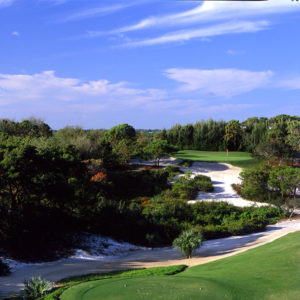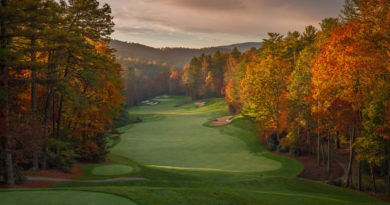Jupiter Hills Club – How the Top One Percent Live – Part 1

Nestled in the seaside hammock and stands of hardwoods on the edge of Jonathan Dickinson State Park in Tequesta, Florida lies the ultra-private Jupiter Hills Club. In the late 1960s, William Elliot, George Fazio, William Clay Ford, Sr. and Bob Hope joined forces to conceive the amazing golf facility that stands there today. Like many of the finest private clubs in America, Jupiter Hills maintains a very selective and exclusive membership criteria. Golf is the main focus here, and with 36 of the finest quality holes in the country set on an amazing piece of rolling terrain, a stellar practice facility, courteous and professional staff and the finest clubhouse I have ever seen, the members are truly spoiled.
The Hills Course was designed in 1970 by George Fazio, and bears a resemblance to Pine valley, where Fazio had been the Pro for many years. The course features 75 feet of elevation changes and most holes are bordered by sugar sand and natural vegetation like palmetto bushes and old pines, severely punishing wayward shots. The ball settles quickly into the soft sand and makes hitting out of it akin to taking a half stroke penalty. The fairways run fast and true, and follow the natural contours of the land, and the greens are some of the fastest and truest putting surfaces anywhere in the country. Rolling a ball across the greens at Jupiter Hills is similar to rolling a ball on a pool table. These greens are a true pleasure – and challenge – to putt. The member tees on the Hills course measure 6973 yards and play to a par of 72. With a course rating of 75.3 and a slope of 146 it is certainly no slouch, but if you feel up to it, you can play the unadvertised black tees. The club has a special scorecard for the black tees, given to players after the pro shop approval to play them. The black tees on the Hills course stretch the course to 7344 yards and it plays to a par 70. The course rating from these tees rises to 77.3 and the slope of 152 is almost at the USGA limit of 155. If the sinister appearance of the special matte black scorecard and the “dead man walking” look you’ll get from the pro shop staff aren’t enough to intimidate you, the opening 5 hole stretch most likely will.
The first hole is a dogleg left par 4 of 493 yards. Into the prevailing wind. If you thought you could just ease your way into the round, you were wrong! After a modest (ahem) 300 yard drive up the left side, you are left with a 190 yard approach to a narrow plateau green. No problem, because if you manage to get through number one unscathed, Fazio gives you a bit of a break on number two with a straightaway par 4 of 469 yards, that is also into the prevailing wind. The green is guarded by a bunker on the right that is about 6 feet deep – about average for the Hills Course. The first par 3 on the course is a modest 187 yards over water. The green is wide and somewhat shallow, but except for the water it is relatively unguarded. The fourth hole is a 578 yard par 5. The fairway is guarded on the right by two deep fairway bunkers and the prevailing wind is left to right, so avoiding these bunkers can be tricky. The hole turns right after the bunkers to a smallish green. The final hole in the opening stretch is a dogleg left, 457 yard par 4 guarded by a huge fairway bunker all the way down the left side, and a green side bunker so deep you can’t see the putting surface from the bottom. The front nine ends with the signature hole – a 227 yard, uphill par 3 over a huge expanse of sand dunes and vegetation. Good luck!
The Village course was built in 1979 by George and Tom Fazio. Tom is George’s nephew, and a highly acclaimed designer in his own right. It is a par 72 and plays to 6800 yards or so. Compared to the Hills course it would seem to be a walk in the park, but in reality it presents a different kind of challenge. The layout is similar in topography to the hills course, but there are more grassy areas and less sugar sand lining the course as its big brother. The course features smaller greens and is slightly less penal, but a stray shot will still be punished. Where as you are virtually forced to hit driver on many holes over on the Hills course due to the sheer length, the Village course rewards placement rather than brute strength. As with the Hills course, the greens are flawless and the entire course is manicured to a level I’ve never seen before. In fact, when I arrived a week before the 2008 Florida State Amateur for a practice round, the Village course had just re-opened after being closed for a 6 month maintenance refresh. I was the first person to play the course. Every tee box was brand spanking new and there wasn’t a single divot, ball mark or blade of grass out of place on the entire golf course! I remember feeling guilty after striking my nine iron from the first fairway. I felt like I had just ruined the perfect golf course. That feeling subsided quickly after I rolled in a birdie putt on the perfect green surface, and my thoughts turned to “I can’t wait to play the next hole!”
Check out part 2 of the story – the 2008 Florida State Amateur Championship!



Pingback: Jupiter Hills Club | Golf Blog by The Orlando Golf Blogger
Pingback: Boxgroove.com - Access Private Golf Courses Without The Membership Fees! | Intothegrain.com
Pingback: Jupiter Hills Club – How The Top One Percent Live – Part 2 : intothegrain.com